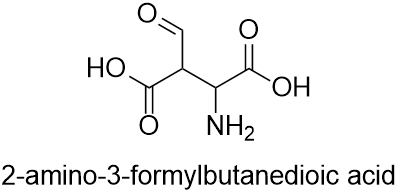The preferred name of the parent structure is butanedioic acid. The name ‘succinic acid’ is retained for general nomenclature with functionalization but no substitution is allowed (see Rule P-65.1.1.2.2); thus, it cannot be used in this case.
The terminal locants ‘1,4’ of butanedioic acid are not cited.
P-14.3.4.1 Terminal locants are not cited in names for mono- and dicarboxylic acids derived from acyclic hydrocarbons and their corresponding acyl halides, amides, hydrazides, nitriles, aldehydes, amidines, amidrazones, hydrazidines, and amidoximes, when unsubstituted or substituted on carbon atoms.
Simple substituent groups that are named by means of prefixes (such as ‘amino’ and ‘formyl’) are arranged alphabetically.
P-14.5 ALPHANUMERICAL ORDER
Alphanumerical order has been commonly called ‘alphabetical order’. As these ordering principles do involve ordering both letters and numbers, in a strict sense, it is best called ‘alphanumerical order’ in order to convey the message that both letters and numbers are involved
Alphanumerical order is used to establish the order of citation of detachable substituent prefixes (not the detachable saturation prefixes, hydro and dehydro), and the numbering of a chain, ring, or ring system when a choice is possible.
(…)
P-14.5.1 Simple prefixes (i.e., those describing atoms and unsubstituted substituents) are arranged alphabetically; multiplicative prefixes, if necessary, are then inserted and do not alter the alphabetical order already established.
Therefore, the correct alphanumerical order for the compound given in the question is x-amino-y-formylbutanedioic acid (not ‘x-formyl-y-aminobutanedioic acid’).
The locants x and y are used to indicate positions of the parent structure at which modifications represented by suffixes occur. The relevant rules concerning the numbering of locants for substituent prefixes are:
P-14.3.5 Lowest set of locants
The lowest set of locants is defined as the set that, when compared term by term with other locant sets, each cited in order of increasing value, has the lowest term at the first point of difference; (…)
and
P-14.4 NUMBERING
When several structural features appear in cyclic and acyclic compounds, low locants are assigned to them in the following decreasing order of seniority:
(…)
(f) detachable alphabetized prefixes, all considered together in a series of increasing numerical order;
(g) lowest locants for the substituent cited first as a prefix in the name;
(…)
In accordance with Rule (f), the compound given in the question could be named as ‘2-amino-3-formylbutanedioic acid’ acid as well as ‘3-amino-2-formylbutanedioic acid’ since the locant set ‘2,3’ is the same in both cases. However, according to Rule (g), this example is named as 2-amino-3-formylbutanedioic acid rather than ‘3-amino-2-formylbutanedioic acid’ since amino is cited first as a prefix in the name.



